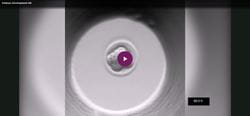
11/25/2019
PITTSBURGH – Though epigenetic disorders – diseases caused by faulty gene expression – are still rare overall, babies born using fertility treatments have up to an 11-fold higher risk of inheriting them. According to a new mouse study from the Magee-Womens Research Institute (MWRI), the problem likely lies with the technology, not the mother’s age.
 The study, published today in Clinical Epigenetics, found that fertility treatments caused epigenetic changes associated with Beckwith-Wiedemann, Silver-Russell and Angelman syndromes in mouse embryos. Surprisingly, maternal age itself had no such effect.
The study, published today in Clinical Epigenetics, found that fertility treatments caused epigenetic changes associated with Beckwith-Wiedemann, Silver-Russell and Angelman syndromes in mouse embryos. Surprisingly, maternal age itself had no such effect.
“Women of advanced maternal age might have one less thing to worry about,” said lead author Audrey Kindsfather, a medical student researcher at MWRI. “We need clinical studies to back that up, but this is a promising animal model that clinical studies could be based on.”
Women are increasingly delaying childbirth, and as a woman ages, so does her reproductive system. The odds of conception go down, while the odds of genetic disorders, such as Down syndrome, go up.
Maternal age might increase the odds of epigenetic disorders too, the researchers reasoned, which could explain the higher incidence of these rare diseases among children born through fertility treatments, since women using these technologies tend to be older. To dissociate these factors, the scientists turned to mice.
Kindsfather and colleagues grouped female mice by age, ranging from adolescence to the mouse equivalent of a 45-year-old woman. Some of the mice in each age group had hormone injections to kick ovulation into high gear or their embryos cultured in a Petri dish – procedures commonly involved in fertility treatments –– while control mice conceived naturally.
Then, the researchers quantified epigenetic changes in the mouse mothers’ embryos by measuring the amount of DNA methylation – molecular locks – clasped around genes associated with epigenetic disorders, preventing them from being expressed.
Hormone therapy and embryo culture both disrupted DNA methylation in these critical spots. When these two procedures were used in combination, the effects were even stronger.
Maternal age, on the other hand, had no impact on DNA methylation patterns around these genes.
“It wasn’t what we were expecting,” said senior author Mellissa Mann, Ph.D., principal investigator with MWRI and associate professor of obstetrics, gynecology and reproductive sciences at the University of Pittsburgh. “We know that as a woman ages, there are a lot of molecular changes happening to her eggs, so we thought that these changes could be leading to abnormal DNA methylation. We were quite surprised that it didn’t.”
Fertility treatments have come a long way since the first “test-tube baby” was born over 40 years ago, but this study highlights that there’s still room for improvement.
“These are wonderful technologies, but not the same as spontaneously conceiving,” Kindsfather said. “Lots more research needs to be done to improve fertility treatments.”
Additional authors on the study include Megan Czekalski, Catherine Pressimone, and Margaret Erisman, all of Pitt and MWRI.
The study was funded, in part, by a grant from the Pennsylvania Department of Health (2018 Health Research Formula Fund). The Department specifically disclaims responsibility for any analyses, interpretations or conclusions. The Howard Hughes Medical Institute (Medical Fellows Research Program) and MWRI also supported this research.
Video Title: Mouse Embryo Developing in a Culture Dish
Video Description: After fertilization, cells within a newly-formed mouse embryo divide and multiply. The cells all have the same DNA, but gene expression patterns diverge as they start to take on different roles. Once there are a few dozen cells, a fluid-filled cavity appears in the center of the embryo. Cells on the surface will become the placenta and the clump of cells nestled to one side will become the fetus. With epigenetic disorders, the gene expression instructions aren’t passed down or maintained properly. In Beckwith-Wiedemann syndrome, for example, the loss of epigenetic marks causes an overgrowth of the placenta and certain parts of the fetus.
Credit: Audrey Kindsfather
















